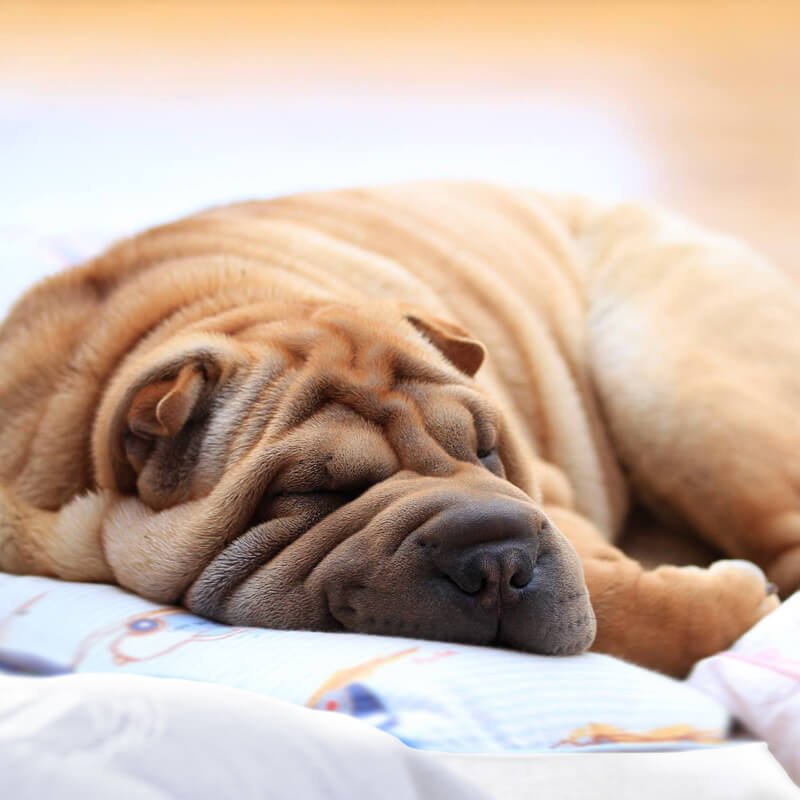Author: Matgo Law, July 2014
The original colours of Shar Pei as I saw in my early days were fawn (light sandy yellow to red fawn), black and cream. Sometimes a ‘rusty’ colour was born in a fawn litter. A rusty-colour is a fawn colour with an overall dark shade (sable-effect), normally with dark brown eyes, dark muzzle, black nails and strong blue-black inside the mouth – strongly black-pigmented. The rusty-colour, however should not give the effect of a black & tan pattern (of a Dobe) or black saddle effect (of a GSD). If either these colour patterns is defined when sighted a Shar Pei (from a distance), it is regarded as non-solid colour and not right. Very occasionally a chocolate might born in a black puppy litter; or a “five-point red” (dilute cream) might appear. These dilute colours were regarded as inferior in pit fighting ability by dog fighting people, therefore were not preserved or developed in breeding. They only popped up in rare occasions of mutation. The many dilute colours as seen nowadays are developed in the recent 20 odd years after Shar Pei has been established and bred overseas.
I do not discriminate against dilute coloured Shar Pei as far as the dog is whole (solid) coloured. I consider chocolate, blue and other dilute colours are correct colours within the breed. Actually when I drafted the ‘first standarď for Shar Pei I did consider the dilute colours (1 knew at that time). In my mind they were also parts of the nature’s making.
Inside the show ring I judge the dilute Shar Pei the same way as 1 judge the norma! colours with black pigment ….. valuing the goods. and the bads of each exhibit according to the Standard, and the overall balance of the type of a Shar Pei. The duty of a judge in the show ring is to access the virtues and see the defects of an exhibit composing a picture of overall balance in type of that breed. lndividual exhibits are then being compared to one another for a pietu re which is more closed to the perfect image.
Colour of is one of the important features of Shar Pei. However it is just one of the many features of the overall type of the breed. So far it is a correct whole colour there is no preference of any particular colour in the Standard.
A good judge should follow the requirements of each and every features as described in the Standard. lf a dilute coloured Shar Pei owns more and better virtues than any other Shar Pei along the line in the ring. He is definitely the winner of his class. 1 always give a hypothetical example regarding judging dilute Shar Pei: There were only 2 male / female Shar Pei in a class for judging in the show ring. They were totally identical to each other on head, proportion, coat, tail and movement. Just like 2 pieces of plastic toys manufactured by the same factory out of the same mode. (of course it can never happened just hypothetic.)
However the only difference of these 2 Shar Pei is the colour: 1 is a normal coloured fawn and 1 is a dilute blue. lf I were thatjudge in the ring, 1 would give the winner to the fawn! Why? lt is not discrimination against dilute. lt is because the fawn has just one thing more than the blue. lt is the black pigment! Fair enough!?
The worry of dilute coloured Shar Pei is not in the ring, but the dilute colour which is lack of black pigment may related to the physical health of the dog, on the eye sight and the ability of hearing. To be honest, it is my worry but I am not sure that lack of black pigment of a Shar Pei would actually affects the norma! abilities of seeing and hearing in some individuals. 1 did not have experience of dilute colours in my breeding as dilute colour was so scarce in my years.
I had never bred a chocolate ….. could have had a couple of five-point red puppies. n other breeds of pure-bred dogs they had problem of such in their histories of development and establishment. For example: the Bull Terrier in its very early all-white breeding development. When the problem was discovered being relating to lack of black pigment, the coloured Staffordshire Bull Terrier blood was introduced for correction of the physical defects.
We can also see in many of the all-white coloured dog breeds, their Standards always call for good strong black pigmentation on the nose, lips, eye ríms and paws. Examples are West Highland White Terrier, Birchon Frise, Maltese etc.
I understand dilute coloured Shar Pei is very popular in some countries and in many varieties of colours nowadays, and also see many repeated dilute to dilute breeding are carried out for a number of generations. Has the shortage of black pigment affected any Shar Pei individuals ability to see and hear? I1 have not seen any reports so far. 1 sincerely hope you as a breeder or owner of dilute colours can help, comment and clarify my worries.

